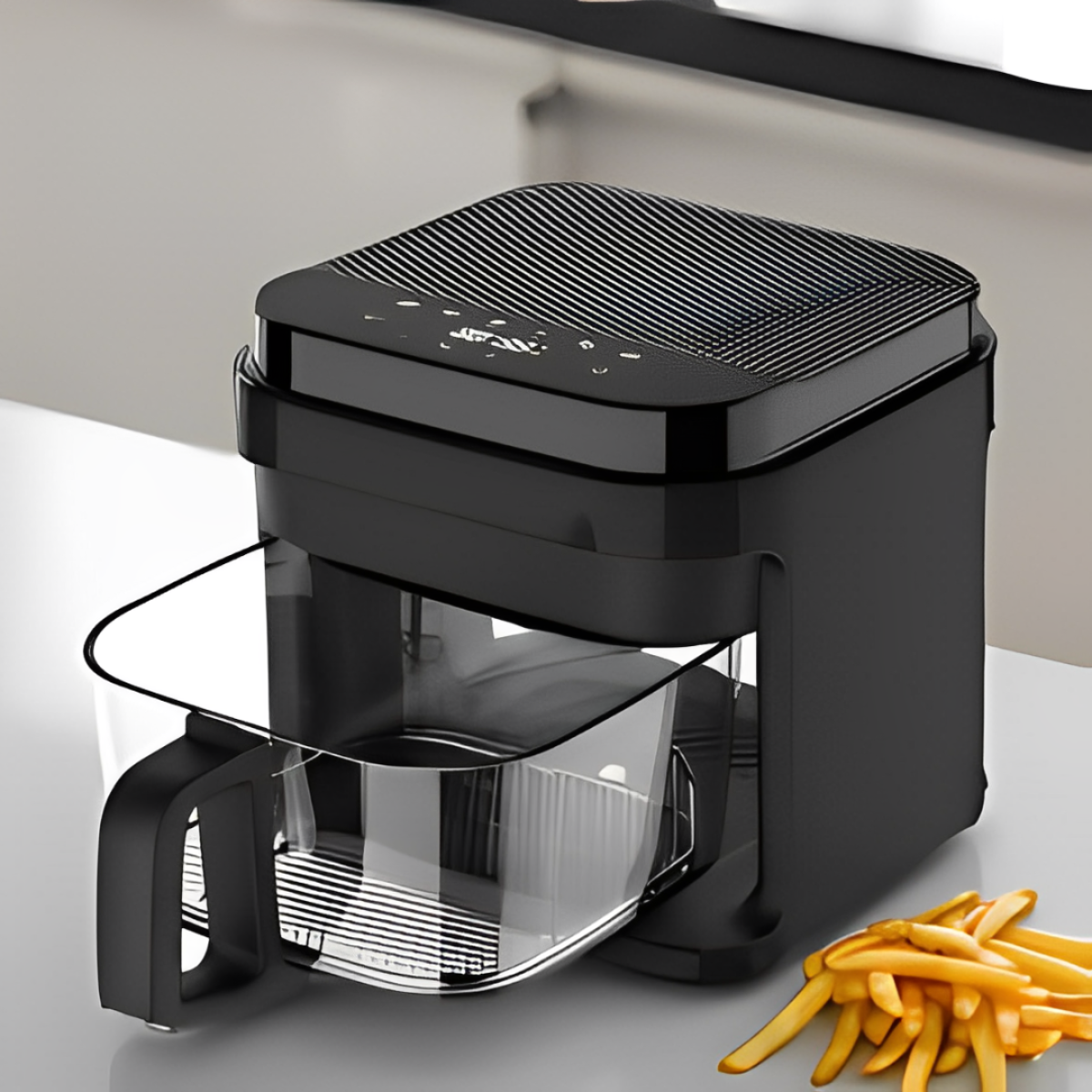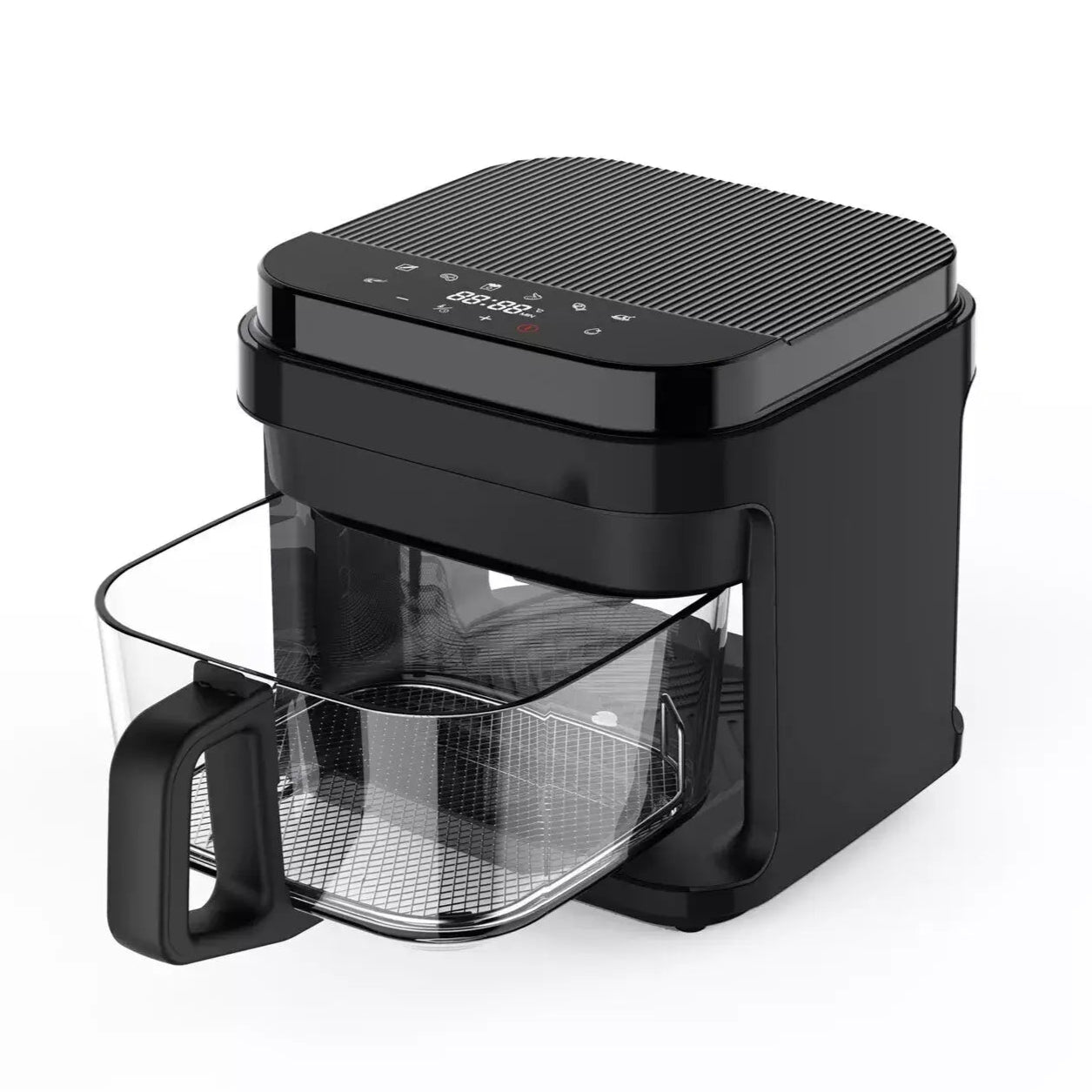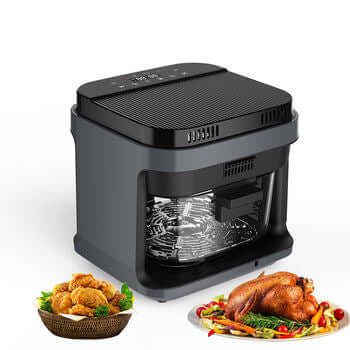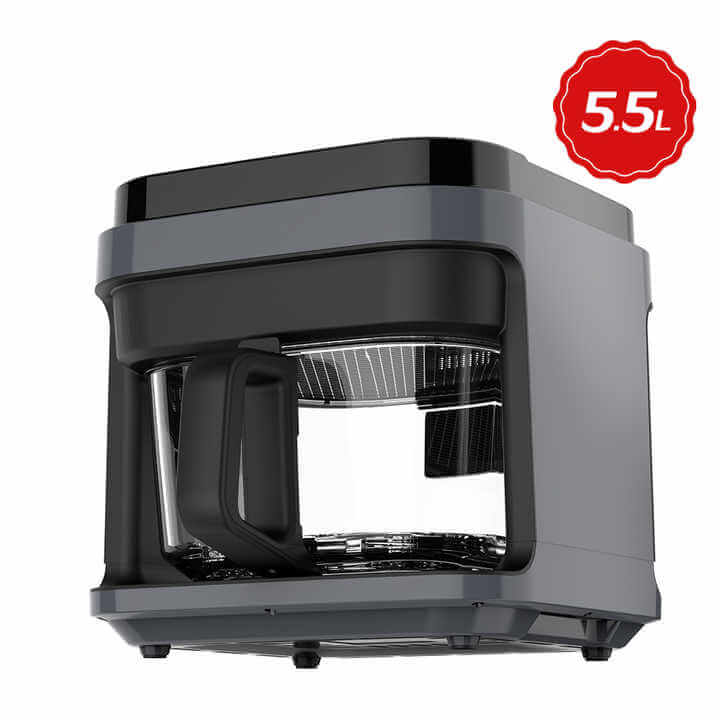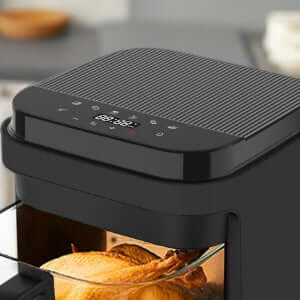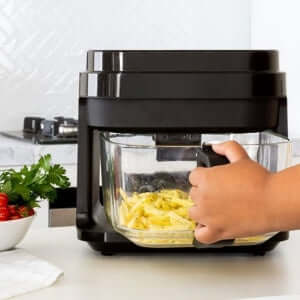Are You Using Your Air Fryer Safely? A Guide to Avoiding Toxins
How can Australians use their air fryer safely and avoid toxins? To use an air fryer safely in Australia, avoid models with PTFE or PFAS non-stick coatings that release harmful fumes. Instead, choose non-toxic options like glass, ceramic, or stainless steel air fryers and follow safe practices—monitor temperature, avoid overheating, and clean regularly to protect your family’s health.
Air fryers have revolutionized the way we cook, allowing us to enjoy our favorite fried foods with a fraction of the guilt. However, not all air fryers are created equal. Many traditional air fryers are coated with non-stick materials that can release harmful toxins when heated.
In this guide, we'll walk you through everything you need to know to use your air fryer safely and avoid exposure to harmful chemicals. We'll also provide you with some tips on how to choose a non-toxic air fryer that's right for you.
Understanding the Hidden Dangers in Your Kitchen
Many people assume that if an appliance is sold in stores, it must be safe to use. Unfortunately, this isn't always the case when it comes to air fryers with traditional non-stick coatings. The convenience of easy cleanup has come at a hidden cost to our health, and many consumers are unaware of the potential risks lurking in their kitchen appliances.
The primary concern with traditional air fryers lies in their non-stick coatings, which are typically made from polytetrafluoroethylene (PTFE), commonly known by the brand name Teflon. While these coatings are convenient, they can release toxic fumes when heated to high temperatures, which is exactly what happens during air frying.
The Science of Toxic Fume Release
When PTFE coatings are heated above 260°C (500°F), they begin to break down and release perfluorinated compounds into the air [1]. These compounds can cause a condition known as polymer fume fever, which presents symptoms similar to the flu, including fever, chills, headache, and respiratory irritation [2].
More concerning are the long-term health effects of chronic exposure to these chemicals. Studies have linked PFAS exposure to various health problems, including:
•Increased cholesterol levels
•Changes in liver enzymes
•Decreased vaccine response in children
•Increased risk of high blood pressure in pregnant women
•Increased risk of kidney and testicular cancer [3]
The problem is compounded by the fact that these chemicals are incredibly persistent in both the environment and the human body, earning them the nickname "forever chemicals."
Temperature Dangers: When Safe Becomes Unsafe
Most air fryers operate at temperatures between 180°C and 200°C (356°F to 392°F), which is generally considered safe for PTFE coatings. However, several factors can cause temperatures to exceed safe limits:
Hot Spots: Uneven heating can create areas within the air fryer that reach much higher temperatures than the set temperature. These hot spots can cause localized breakdown of the coating.
Preheating: Many people preheat their air fryers empty, which can cause temperatures to spike well above the set temperature before food is added to moderate the heat.
Malfunctioning Thermostats: As air fryers age, their temperature control systems can become less accurate, potentially leading to overheating.
High-Fat Foods: Foods with high fat content can cause oil to splatter and create localized high-temperature areas that exceed the coating's safe operating range.
Identifying Signs of Coating Breakdown
It's crucial to know the warning signs that your air fryer's coating may be breaking down:
•Discoloration or darkening of the coating
•Peeling, flaking, or bubbling of the surface
•Scratches or gouges that expose the underlying metal
•A chalky or powdery residue on the surface
•Sweet or chemical odors during use
•Unusual smells that weren't present when the appliance was new
•Persistent odors that linger after cleaning
•Food sticking more than usual
•Uneven cooking or hot spots
•Difficulty cleaning despite proper maintenance
If you notice any of these signs, it's time to stop using your air fryer immediately and consider replacing it with a non-toxic alternative.
The Safest Air Fryer Materials: A Deep Dive
To ensure safe cooking, it's essential to choose an air fryer made from materials that won't release harmful chemicals when heated:
Glass: The Ultimate Safe Choice
Glass air fryers, such as the Terra Wellness 5.5L Glass Air Fryer, represent the safest option available. Borosilicate glass is completely chemically inert, meaning it won't react with food or release any compounds when heated. The transparency also allows you to monitor your food throughout the cooking process, ensuring perfect results every time.
The safety benefits of glass extend beyond just chemical inertness:
•No risk of coating degradation over time
•Easy to inspect for damage or wear
•Naturally non-stick properties that don't diminish
•Complete recyclability at end of life
Ceramic: A Natural Alternative
Ceramic coatings made from natural minerals offer another safe alternative to traditional non-stick surfaces. High-quality ceramic coatings are free from PFAS, PFOA, and PTFE, making them much safer than traditional options.
However, not all ceramic coatings are created equal. When choosing a ceramic air fryer, look for:
•100% ceramic coating (not ceramic-infused)
•Lead-free and cadmium-free certifications
•Reputable manufacturer with safety testing documentation
Stainless Steel: Industrial-Grade Safety
Stainless steel air fryers offer uncompromising safety and durability. Food-grade stainless steel (typically 304 or 316 grade) is non-reactive and won't leach chemicals into your food, even at high temperatures.
While stainless steel isn't naturally non-stick, proper cooking techniques can minimize sticking:
•Preheat the air fryer before adding food
•Use a light coating of high-heat oil
•Don't overcrowd the cooking basket
•Allow food to develop a crust before attempting to move it
Safe Cooking Practices for Any Air Fryer
Regardless of which type of air fryer you choose, following safe cooking practices is essential:
Temperature Management
Monitor Cooking Temperatures: Use an external thermometer to verify that your air fryer is maintaining the correct temperature. This is especially important for older units or those without digital displays.
Avoid Overheating: Never exceed the manufacturer's recommended maximum temperature. If a recipe calls for higher temperatures, consider using a different cooking method.
Gradual Temperature Changes: When possible, allow your air fryer to heat up gradually rather than jumping immediately to high temperatures.
Proper Ventilation
Ensure Adequate Airflow: Always use your air fryer in a well-ventilated area. If you notice any unusual odors, immediately turn off the unit and ventilate the area.
Avoid Enclosed Spaces: Never use an air fryer inside a cabinet or other enclosed space where fumes could accumulate.
Consider Air Purification: If you're concerned about air quality, consider using an air purifier with a HEPA filter in your kitchen during cooking.
Regular Maintenance and Inspection
Daily Cleaning: Clean your air fryer after each use to prevent buildup of food residue that could burn and create hot spots.
Weekly Deep Cleaning: Perform a thorough cleaning weekly, paying special attention to heating elements and air circulation areas.
Monthly Inspection: Regularly inspect your air fryer for signs of wear, damage, or coating breakdown. Replace the unit if you notice any concerning changes.
What to Do If You've Been Using an Unsafe Air Fryer
If you've been using an air fryer with a traditional non-stick coating, don't panic. Here's what you should do:
Immediate Steps
1.Stop Using the Unit: If you notice any signs of coating breakdown, stop using the air fryer immediately.
2.Ventilate the Area: Open windows and use fans to clear any lingering fumes from your kitchen.
3.Clean Thoroughly: Clean all surfaces in your kitchen that may have been exposed to fumes or particles.
Health Monitoring
While occasional exposure to PFAS chemicals is unlikely to cause immediate health problems, it's worth discussing your concerns with a healthcare provider, especially if you've been using a damaged air fryer regularly.
Safe Disposal
When disposing of an old air fryer with non-stick coating:
•Don't put it in regular household recycling
•Check with local hazardous waste facilities for proper disposal options
•Some manufacturers offer take-back programs for old appliances
Making the Switch to Non-Toxic Air Frying
Transitioning to a non-toxic air fryer is one of the best investments you can make for your family's health. Here's how to make the switch smoothly:
Choosing the Right Replacement
Consider your cooking habits and preferences when selecting a new air fryer:
•For maximum safety and ease of use: Choose a glass air fryer like the Terra Wellness model
•For excellent non-stick properties: Consider a high-quality ceramic option
•For maximum durability: Opt for a stainless steel model
Adjusting Your Cooking Techniques
Different materials may require slight adjustments to your cooking methods:
•Glass and ceramic air fryers typically require less oil than stainless steel
•Stainless steel may require preheating and careful temperature management
•All non-toxic materials may have slightly different cooking times than your old unit
Educating Your Family
Make sure everyone in your household understands the importance of using the air fryer safely:
•Explain why you made the switch
•Teach proper operating procedures
•Establish rules for maintenance and cleaning
The Long-Term Benefits of Safe Air Frying
Making the switch to a non-toxic air fryer offers numerous long-term benefits:
Health Benefits
•Elimination of PFAS exposure from cookware
•Reduced risk of polymer fume fever
•Peace of mind about food safety
•Better indoor air quality
Performance Benefits
•More consistent cooking results
•Better food flavor without chemical interference
•Longer appliance lifespan
•Easier maintenance and cleaning
Environmental Benefits
•Reduced contribution to PFAS environmental contamination
•More sustainable materials that can be recycled
•Longer product lifespan reduces waste
Conclusion: Your Health is Worth the Investment
The convenience of traditional non-stick air fryers simply isn't worth the potential health risks. By choosing a non-toxic alternative like a glass, ceramic, or stainless steel air fryer, you're making a proactive choice to protect your family's health and well-being.
The Terra Wellness 5.5L Glass Air Fryer exemplifies what to look for in a safe, non-toxic air fryer: high-quality materials, transparent construction for easy monitoring, and a commitment to chemical-free cooking. While the initial investment may be higher than traditional options, the long-term benefits to your health, safety, and peace of mind make it a worthwhile investment.
Remember, your kitchen should be a place of nourishment and health, not a source of toxic exposure. By taking the time to choose safe, non-toxic appliances, you're creating a healthier environment for your family and setting a positive example for future generations.
Don't wait until you notice signs of coating breakdown or experience health symptoms. Make the switch to non-toxic air frying today, and enjoy the peace of mind that comes with knowing you're cooking safely for your loved ones.
Use code BLOG20 for 20% OFF now.
FAQs About Air Fryer Safety in Australia
Q1: What toxins can traditional air fryers release?
A: PTFE/PFAS coatings can break down at high heat, releasing toxic fumes and “forever chemicals” linked to serious health risks.
Q2: Which air fryer materials are safest in Australia?
A: Glass is the safest, followed by certified ceramic and food-grade stainless steel. All are PFAS-free and chemical-safe.
Q3: How do I know if my air fryer coating is breaking down?
A: Look for peeling, discoloration, flaking, chemical odors, or unusual sticking—these are signs it’s time to replace it.
Q4: Are glass air fryers better than ceramic or stainless steel?
A: Yes—glass is completely inert, PFAS-free, easy to clean, and lets you monitor food visually for safer, more precise cooking.
Q5: What are safe cooking practices for any air fryer?
A: Avoid preheating empty, never exceed the max temperature, cook in a well-ventilated space, and clean after each use.
Q6: What should I do if I’ve used an unsafe air fryer?
A: Stop using it, ventilate your kitchen, clean surfaces, monitor your health, and switch to a non-toxic model.
For further information please refer to:
Can You Put Glass in an Air Fryer? Safe Use Guide
How to Clean an Air Fryer Glass Door? Streak-Free Tips That Work







